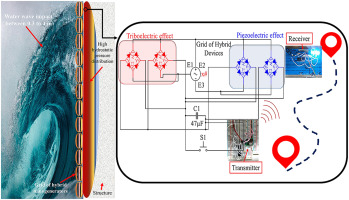Nano Energy ( IF 17.6 ) Pub Date : 2020-03-13 , DOI: 10.1016/j.nanoen.2020.104701 Ulises Tronco Jurado , Suan Hui Pu , Neil M. White

|
This paper describes an alternative approach for improving the output power performance for coastal wave impact energy harvesting systems, located at water-structure interfaces. This is achieved by simultaneously coupling the triboelectric and piezoelectric effects, exhibited in some materials. The use of finite element modelling, and experimental electrical characterization, enables the integration of hybrid devices into a breaking water wave generator tank. This provides a mechanism for simulating actual ocean wave conditions at low frequencies (0.7 Hz – 3 Hz). Enhancements in the output performance by a factor of 2.24 and 3.21, relative to those obtained from using single triboelectric and piezoelectric nanogenerators, were achieved. This is demonstrated by evaluating the output current, voltage, transferred charge, and charging performance from a grid of up to four hybrid devices connected to capacitors of different capacitance values. Such hybrid devices were capable of powering a one-way wireless transmitter with a generated output power between 340.85 μW to 2.57 mW and sent a signal to a receiver at different distances from 2 m to 8 m. The research shows that such an integrated device can provide a promising mechanism for developing high-performance energy harvesting mechanisms for ocean wave impact to drive self-powered systems having an average power consumption of 1 to 100 mW. Further, it is estimated that through the construction of large water-hybrid nanogenerator-structure interfaces, output powers of approximately 21.61 W can be generated for powering networks of self-powered sensing systems in smart large-scale applications.
中文翻译:

混合纳米发电机的网格,用于改善海浪冲击能量收集自供电应用
本文介绍了一种替代方法,用于改善位于水结构界面处的沿海波浪冲击能量收集系统的输出功率性能。这是通过同时耦合某些材料中表现出的摩擦电和压电效应来实现的。使用有限元建模和实验电气特性,可以将混合动力设备集成到破水波发生器箱中。这提供了一种模拟低频(0.7 Hz – 3 Hz)下实际海浪条件的机制。与使用单个摩擦电和压电纳米发电机获得的输出性能相比,输出性能提高了2.24和3.21倍。通过评估输出电流,电压,转移的电荷,以及最多四个混合设备连接到具有不同电容值的电容器的网格中的充电性能。这种混合设备能够为单向无线发射器供电,产生的输出功率在340.85μW至2.57 mW之间,并以2 m至8 m的不同距离向接收器发送信号。研究表明,这种集成设备可以为开发用于海浪冲击的高性能能量收集机制提供有希望的机制,以驱动平均功耗为1到100 mW的自供电系统。此外,据估计,通过构造大型水混合式纳米发电机结构接口,可以产生约21.61 W的输出功率,以为智能大规模应用中的自供电传感系统的网络供电。


























 京公网安备 11010802027423号
京公网安备 11010802027423号